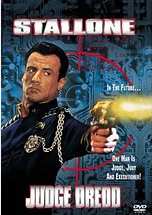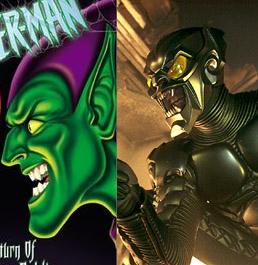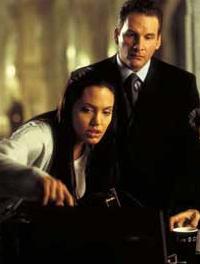 For example, Judge Dredd in the comics has always been characterized by
never showing his face (at least to the readers). In the movie Stallone
had to show his face, of course, completely destroying this trademark.
For example, Judge Dredd in the comics has always been characterized by
never showing his face (at least to the readers). In the movie Stallone
had to show his face, of course, completely destroying this trademark.
Actually the idea of making a movie from a comic (or computer game) doesn't irritate me, but I had to keep the title of the page short.
What irritates me is when they take a comic (or computer game) franchise and make a movie about it drastically changing the contents of the original, often making a complete mock of it and destroying its whole idea.
One very general and drastic difference between comics and movies made from them is that in comics villains basically never die. While this is often done to keep the franchize alive and running, in the universe of the comics it has a rather rational and logical explanation: The heros are not killers. They stop the villains and put them to jail. They don't kill the villains. They are not murderers.
However, Hollywood has this unwritten rule that the bad boss must die at the end of the movie, and this rule is so holy that it cannot be broken even when making a movie from a comic (where bad guys basically never die). Thus bad guys constantly die in movies, completely destroying any possibility of continuing the series with that villain in particular, and basically making the heros murderers, which is morally very questionable.
Individual conversions often have their diverse problems:
 For example, Judge Dredd in the comics has always been characterized by
never showing his face (at least to the readers). In the movie Stallone
had to show his face, of course, completely destroying this trademark.
For example, Judge Dredd in the comics has always been characterized by
never showing his face (at least to the readers). In the movie Stallone
had to show his face, of course, completely destroying this trademark.
In Doom 3, the game, the idea is that teleportation research performed in Mars opens an unexpected rift to some kind of hell dimension from which monstruous beings pour in to this universe, and space marines are sent by spaceship to fight them off (well, actually the attack happens only after the protagonist has arrived at Mars for regular duty). In Doom, the movie, what is done in Mars is biological research and all the monsters (not quite such a varied set of them like in the game) are transformed humans. Marines go there to fight them off after the accident happens and they go there by teleportation, not spaceships. So in the movie we have basically just one type of monster, former humans. No hellish creatures. And the protagonist is certainly not alone for most of the movie, like he is in the game.
In the comics, Reed Richards (Mister Fantastic) is probably at least
50 years old. In the movie he is a man in his early thirties. Why? Also
one of the coolest characters in the whole movie, Dr Doom, is shown in
full costume for less than a minute. Why?!
 One of the arch-nemeses of Spiderman is the Green Goblin who wears a
rubber mask (or whatever material) which fits his face and shows his
expressions. In the movie he wears a metallic mask which resembles only
vaguely the comic. Also spiderman has changed to create his web from his
own body, seemingly from a rather ample supply stored in hammerspace
(not that the original comic uses less of a hammerspace, but at least
it tries to explain it with technobabble).
One of the arch-nemeses of Spiderman is the Green Goblin who wears a
rubber mask (or whatever material) which fits his face and shows his
expressions. In the movie he wears a metallic mask which resembles only
vaguely the comic. Also spiderman has changed to create his web from his
own body, seemingly from a rather ample supply stored in hammerspace
(not that the original comic uses less of a hammerspace, but at least
it tries to explain it with technobabble).
Batman wears a fitting and flexible suit which allows full body movement.
It might not be bullet-proof (except for his cape, as shown in some comics),
but Batman seldom attacks armed enemies head-on anyways, but instead uses
sneakier tactics which avoid shootings altogether. In the movies he is
fitted inside a bulky body armor which hardly allows him to move, and
he even can't turn his head! How is Batman supposed to fight enemies when
he can't turn his head? When I heard that the newest Batman movie was a
complete reboot of the series and all the previous movies were discarded,
I was hoping that this issue would be corrected, but no: He still can't
even turn his head, and his suit is even bulkier than before. He looks
just ridiculous when he tries to turn his head but can't.
 |
| Did Lara find a youth potion which she gave to her butler? |
The 2004 movie Catwoman has next-to-nothing to do with the Catwoman in the comic books. As wikipedia puts it: In the movie Catwoman has super powers, which she lacks in the comics. Her lycra suit was replaced with slashed leather pants, a bra and a mask-cap, and she leaps from rooftop to rooftop in spike heels. As the movie character differs so widely from her comic source, the character has been cited as "Catwoman In Name Only".
The 2005 movie Alone in the dark has basically nothing to do with the videogame of the same name (except that it attempts to be a horror movie). Clearly just an attempt at making money using a known franchise with no regard whatsoever in actually adapting the game.